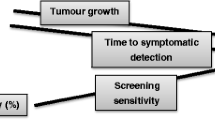Abstract
It has been suggested that alteration of the distribution of histological grades, that has been found in screening programmes, is evidence for progression in histological grade with increasing size. A predictive model, that was based upon estimated growth data from an unselected series of 98 new primary breast cancers, is used to estimate the proportions of tumors that would be diagnosed according to limiting screen diagnostic and clinical diagnostic sizes after particular screening intervals; windows of opportunity are created. The results show that the limitations imposed by time and size criteria alter the distribution of growth rates of tumours that may appear in the windows. Small screen diagnostic sizes and short screening intervals allow only the most rapidly growing tumours to reach large sizes. This produces an apparent association of grade 3 tumours with large size. Interval cancers are also likely to be more rapidly growing while the more slowly growing tumours will be diagnosed at the subsequent screen to produce a spurious association of slowly growing grade 1 tumours with small size. We conclude that the evidence from screening does not support the thesis of progression of histological grade with the ageing of the tumour, since the changes that have been observed are predictable from a simple model based upon patterns of tumour growth rates and the relationships between growth rate and histology.
Similar content being viewed by others
References
Tabár L, Duffy SW, Vitak B, Chen H-H, Prevost TC: The natural history of breast carcinoma. What have we learned from screening? Cancer 86: 449-462, 1999
Tubiana M, Koscielny S: The rationale for the early diagnosis of cancer. The example of breast cancer. Acta Oncol 38: 295-303, 1999
Millis RR, Barnes DM, Lampejo OT, Egan MK, Smith P: Tumour grade does not change between primary and recurrent mammary carcinoma. Eur J Cancer 34: 548-553, 1998
Andersen J, Poulsen HS: Relationship between estrogen receptor status in the primary tumor and its regional and distant metastases. An immunohistochemical study in human breast cancer. Acta Oncol 27: 761-765, 1988
Roylance R, Gorman P, Harris W, Liebmann R, Barnes D, Hanby A, Sheer D: Comparative genomic hybridization of breast tumours stratified by histological grade reveals new insights into the biological progression of breast cancer. Cancer Res 59: 1433-1436, 1999
Johnson AE, Shekhdar J: Interval cancers in the National Health Service Breast Screening Programme. Br J Radiol 68: 862-869, 1995
Charbit A, Malaise EP, Tubiana M: Relation between the pathological nature and the growth rate of human tumours. Eur J Cancer 7: 307-315, 1971
Johnson AE, Bennett MH, Cheung CWD, Cox SJ, Sales JELS: The management of individual breast cancers. The Breast 4: 100-111, 1995
Elston CW: Grading of invasive carcinoma of the breast. In: Page DL, Anderson TJ (eds) Diagnostic Histopathology of the Breast. Churchill Livingstone, Edinburgh, London, Melbourne, New York, 1987, pp 300-311
Cheung CWD, Johnson AE: Carcinoma of the breast: measurement and the management of treatment. II. The regression of tumours. Br J Radiol 64: 121-132, 1991
Woodman CBJ, Threlfall AG, Boggis CRM, Prior P: Is the three year breast screening interval too long? Occurrence of interval cancers in NHS breast screening programme's north western region. BMJ 310: 224-226, 1995
Collins VP, Loeffler MD, Tivey H: Observations on growth rates of human tumors. Am J Roetgenol 76: 988-1000, 1956
Tabár L, Fagerberg G, Duffy SW, Day NE, Gad A, Gröntoft O: Update of the Swedish two-county program of mammographic screening for breast cancer. Radiol Clinics of North Am 30: 187-210, 1992
Tubiana M, Koscielny S: The natural history of breast cancer: implications for a screening strategy. Int J Radiation Oncol Biol Phys 19: 1117-1120, 1990
Steel GG: Growth Kinetics of Tumours. Clarendon Press, Oxford, 1977
Bloom HJG, Richardson WW: Histological grading and prognosis in breast cancer. Br J Cancer 11: 359-377, 1957
Koscielny S, Tubiana M, Lê MG, Valleron AJ, Mouriesse H, Contesso G, Sarrazin D: Breast cancer: relationship between the size of the primary tumour and the probability of metastatic dissemination. Br J Cancer 49: 709-715, 1984
Bloom HJG: Prognosis in carcinoma of the breast. Br J Cancer 4: 259-367, 1950
Duffy SW, Tabár L, Fagerberg G, Gad A, Gröntoft O, South MC, Day NE: Breast screening, prognostic factors and survival-results from the Swedish two county study. Br J Cancer 64: 1133-1138, 1991
Connor AJM, Pinder SE, Elston CW, Bell JA, Wencyk P, Robertson JFR, Blamey RW, Nicholson RI, Ellis IO: Intratumoral heterogeneity of proliferation in invasive breast carcinoma evaluated with MIB1 antibody. The Breast 6: 171-176, 1997
Teixera MR, Pandis N, Bardi G, Andersen JA, Mitelman F, Heim S: Clonal heterogeneity in breast cancer: karyotypic comparisons of multiple intra and extra-tumourous samples from 3 patients. Int J Cancer 63: 63-68, 1995
Johnson AE: Riposte to guest commentaries on ‘Problems associated with randomized controlled clinical trials in breast cancer’. J Eval Clin Pract 4: 231-236, 1998
Author information
Authors and Affiliations
Rights and permissions
About this article
Cite this article
Johnson, A., Shekhdar, J. Does breast cancer grade worsen with time? Evidence from breast screening. Breast Cancer Res Treat 68, 261–271 (2001). https://doi.org/10.1023/A:1012273922325
Issue Date:
DOI: https://doi.org/10.1023/A:1012273922325




